
———————–

~~~~~~~~~~~~~~~~~~~~~~~~~~~~~~
A complex of buildings in the heart of New York City, the Morgan Library & Museum began as the private library of financier Pierpont Morgan, one of the preeminent collectors and cultural benefactors in the history of the United States. Today it is a museum, independent research library, music venue, architectural landmark, and historical site. A century after its founding, the Morgan maintains a unique position in the cultural life of New York City and is considered one of its greatest treasures. With the 2006 reopening of its newly renovated campus, designed by renowned architect Renzo Piano, and the 2010 refurbishment of the original library, the Morgan reaffirmed its role as an important repository for the history, art, and literature of Western civilization from 4000 B.C. to the twenty-first century.
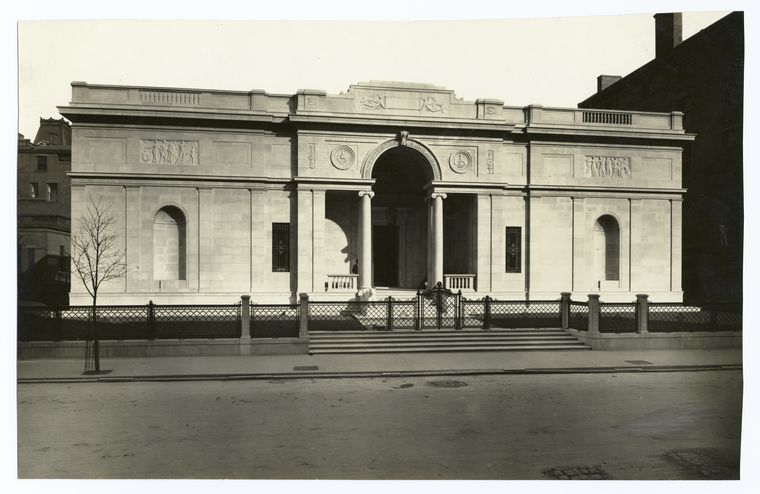
The Morgan Library, ca.1906. McKim, Mead & White, Architects. Wurts Brothers, Photographer. The Miriam and Ira D. Wallach Division of Art, Prints and Photographs: Photography Collection, The New York Public Library. “The Morgan Library, New York” The New York Public Library Digital Collections. 1860 – 1920
———————–
1906 McKim Building
In 1902 Pierpont Morgan chose architect Charles Follen McKim (1847-1909) of the prominent firm McKim, Mead and White to design a library to house his growing collection of rare books and manuscripts. Adjacent to Morgan’s home, which stood on the corner of Madison Avenue and 36th Street, McKim created a majestic structure in a classical style based upon villas of the Italian Renaissance. The exterior is constructed of Tennessee pink marble, the blocks set with such precision that virtually no mortar was used. A simple recessed portico is flanked by a pair of stone lionesses. Completed in 1906, Mr. Morgan’s Library–as it was called for many years–is the historic heart of today’s Morgan Library & Museum.
——————– NEWS UPDATE / January 12, 2018 ——————–
The Morgan Library & Museum receives grant from the Sherman Fairchild Foundation to restore the exterior of its 1906 McKim building, the original library of founding benefactor, Pierpont Morgan.
The Morgan restored its interiors in 2010, but there has never been a comprehensive restoration of the exterior. Unsurprisingly, the façade has shown deterioration over the years. In addition, important elements of sculptural work, including two large lionesses by Edward Clark Potter, need specialized art conservation.
————————————————————-
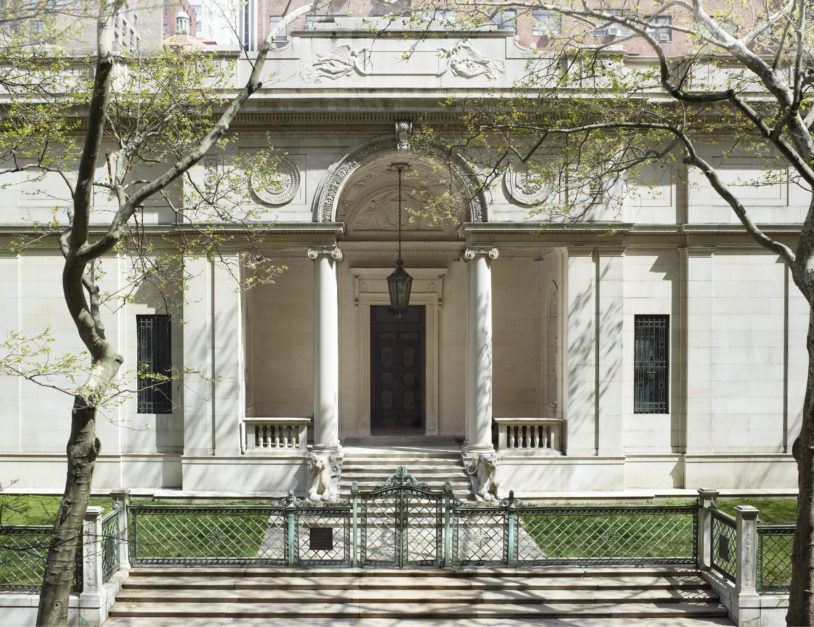
~~~~~~~~~~~~~~~~~~~~~~~~~~~~~~~~~~~~~~~~~~~
The Rotunda
The Rotunda is the dramatic center of the McKim building. Its intricate and elaborately decorated ceiling depicts figures from classical antiquity and the great literary epochs of the past, including Homer, Dante, and Petrarch. The splendor of color and texture is supplied by variegated marble surfaces and columns, mosaic panels and columns of lapis lazuli.

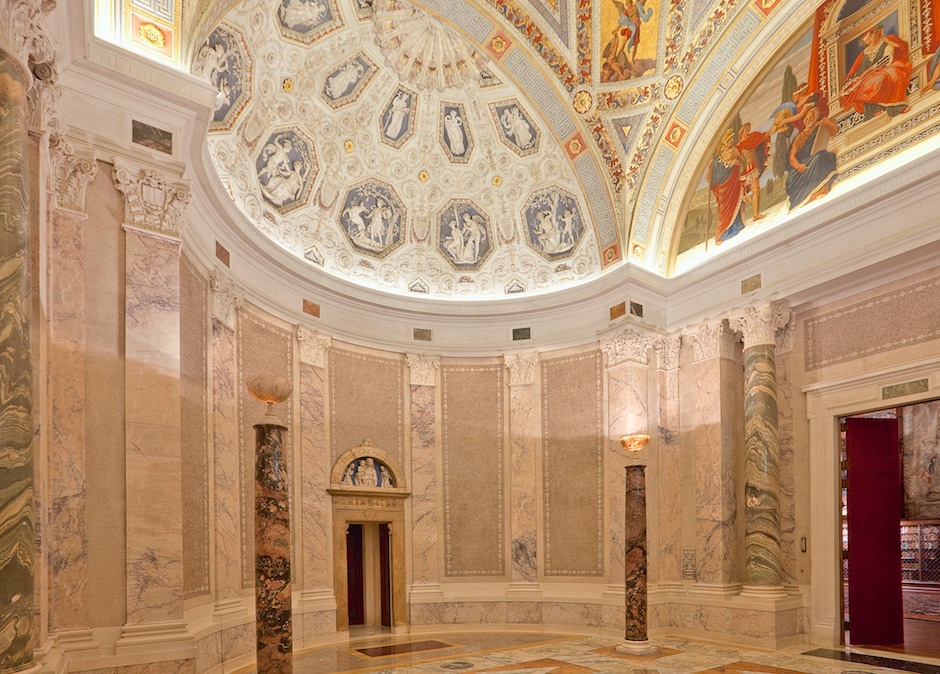
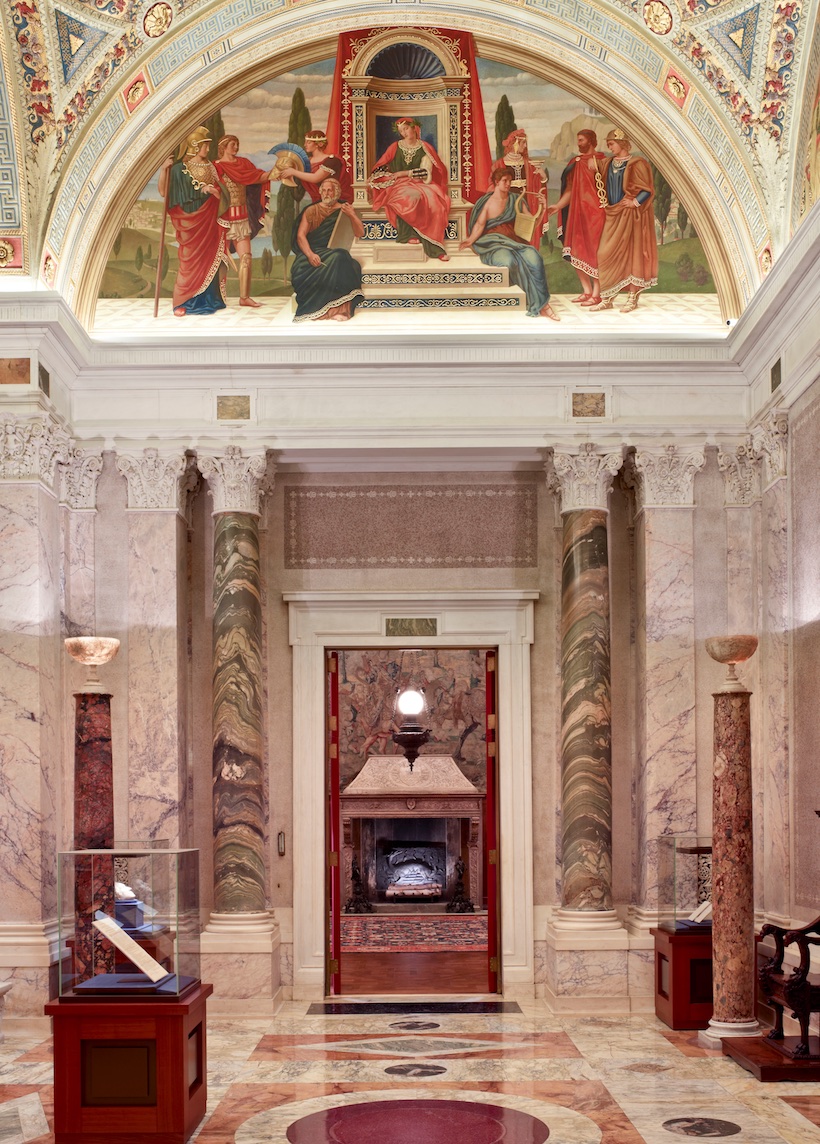
On display in the Rotunda are objects from the Morgan’s outstanding collection of Americana, including such great works as autograph letters by Thomas Jefferson and Abraham Lincoln, a life mask of George Washington, copies of the first Bible printed in America, and the Declaration of Independence.
~~~~~~~~~~~~~~~~~~~~~~~~~~~~~~~~~~~~
Pierpont Morgan’s Library or East Room
Pierpont Morgan’s stunning Library, also known as the East Room, is defined by thirty-foot walls, lined floor to ceiling with triple tiers of bookcases made of inlaid Circassian walnut and featuring volumes of European literature from the sixteenth through twentieth centuries.
Featured on the decorative ceiling by noted muralist Henry Siddons Mowbray (1858-1928) are cultural luminaries of the past, including Socrates, Galileo, Botticelli, and Michelangelo, as well as signs of the zodiac.
Above the room’s grand fireplace is a sixteenth-century tapestry depicting the triumph of Avarice, from a series depicting the Seven Deadly Sins.
Displayed in the library are some of the Morgan’s finest literary and historical manuscripts, medieval and Renaissance illuminated texts, music manuscripts, and printed books and bindings.
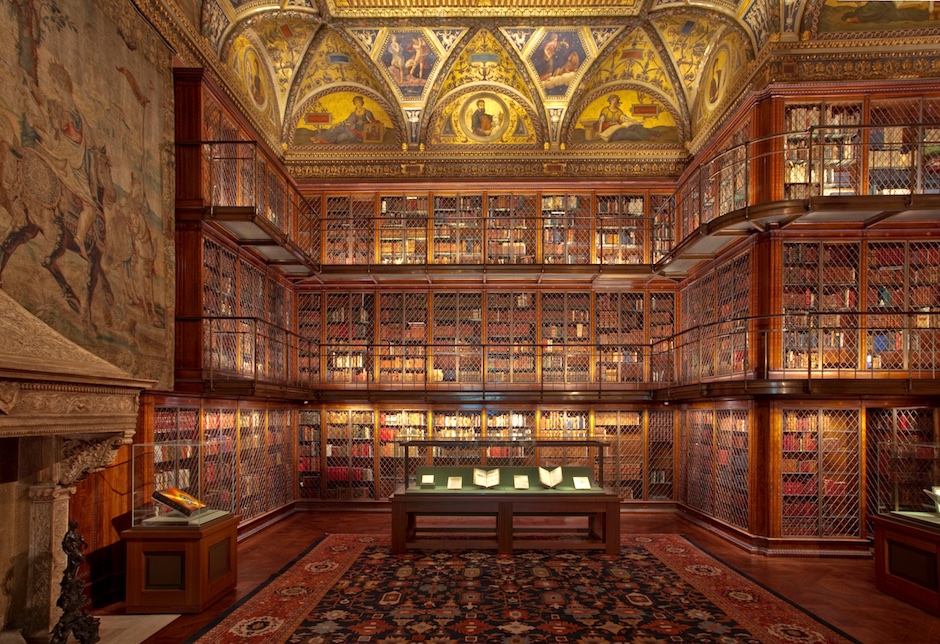



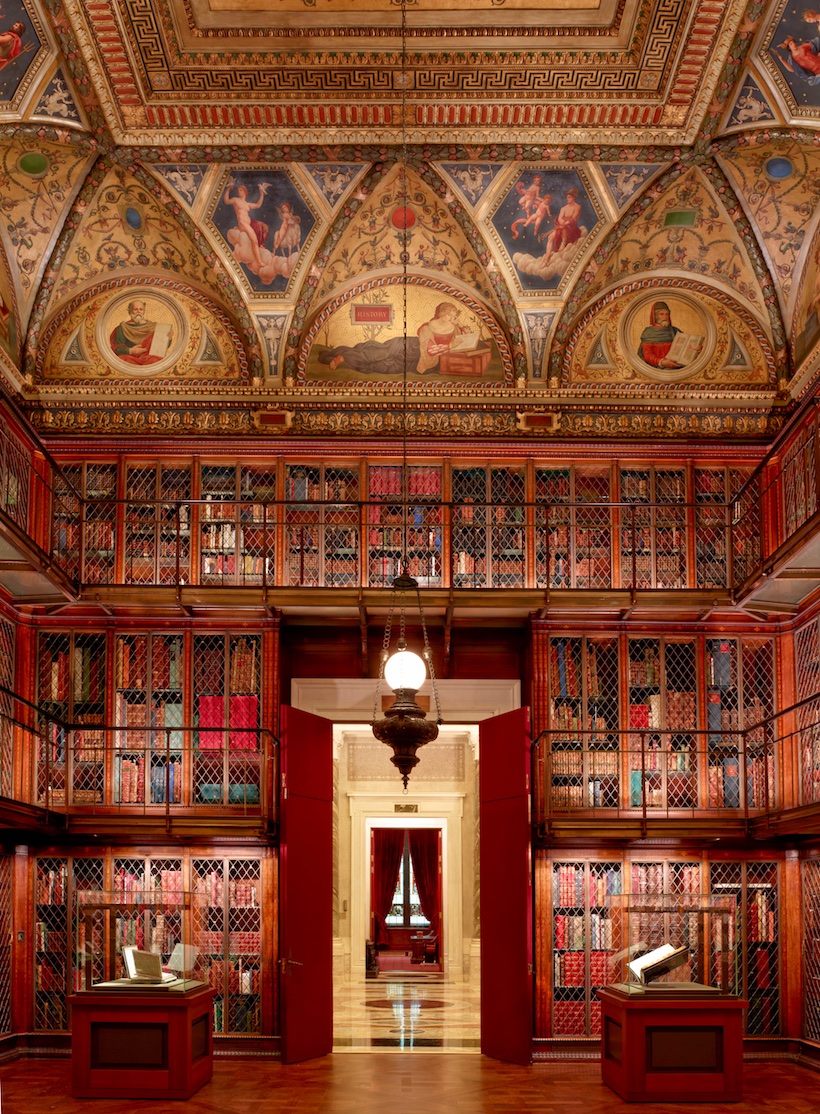
~~~~~~~~~~~~~~~~~~~~~~~~~~~~~~~~~~~~
Pierpont Morgan’s Study or West Room
The Renaissance-inspired furnishings of the Study, or West Room, and the paintings, sculpture, and decorative arts displayed reveal the breadth of Pierpont Morgan’s interests and activity as a collector. The room, used by Morgan in the early 1900s for personal business, is defined by its sixteenth-century Florentine coffered wooden ceiling, red silk damask wall coverings patterned after the wall in the Roman palace of famed Renaissance banker Agostino Chigi, and fifteenth-to seventeenth-century stained glass fragments embedded into the windows.
Of especial note in the West Room are paintings by Hans Memling, Francesco Francia, Perugino, and Jacopo Tintoretto, a bronze St. John the Baptist after Michelozzo, and a 1530 Verrazano globe–one of the earliest known dated globes.
Th steel-lined vault in the southeast corner of the room, equipped with a bank vault door and combination lock, is where Pierpont Morgan housed his most valued acquisitions.

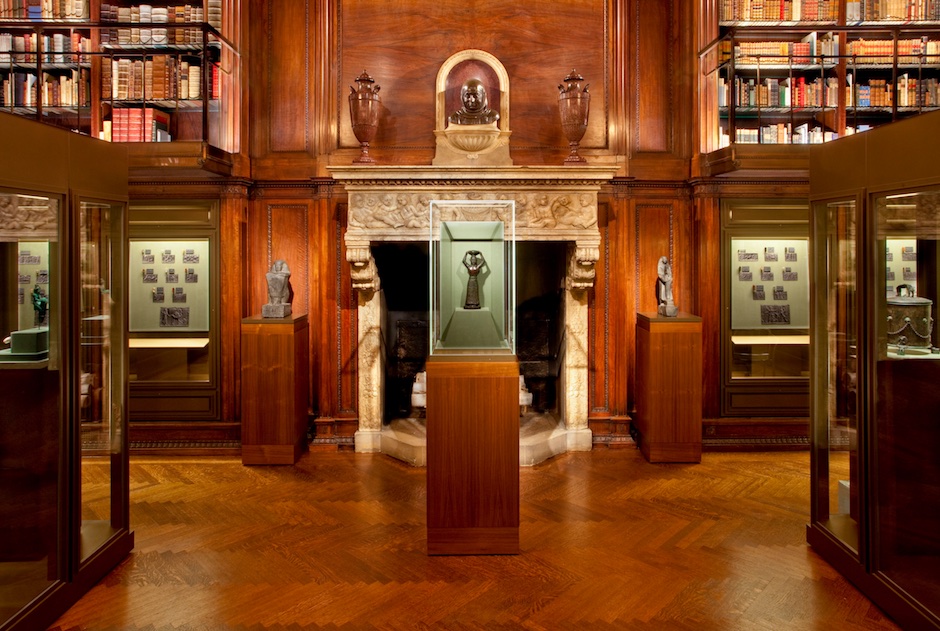
~~~~~~~~~~~~~~~~~~~~~~~~~~~~~~~~~~~~
2006 Renzo Piano Expansion
The 2006 expansion was the Morgan’s most ambitious building project in the museum’s history. It included a new entrance on Madison Avenue, greatly increased exhibition space, a new performance hall and a dedicated educational center for school children, enlarged and modernized scholarly facilities including a new Reading Room, state-of-the-art collection storage, and a variety of visitor amenities, highlighted by two new restaurants.
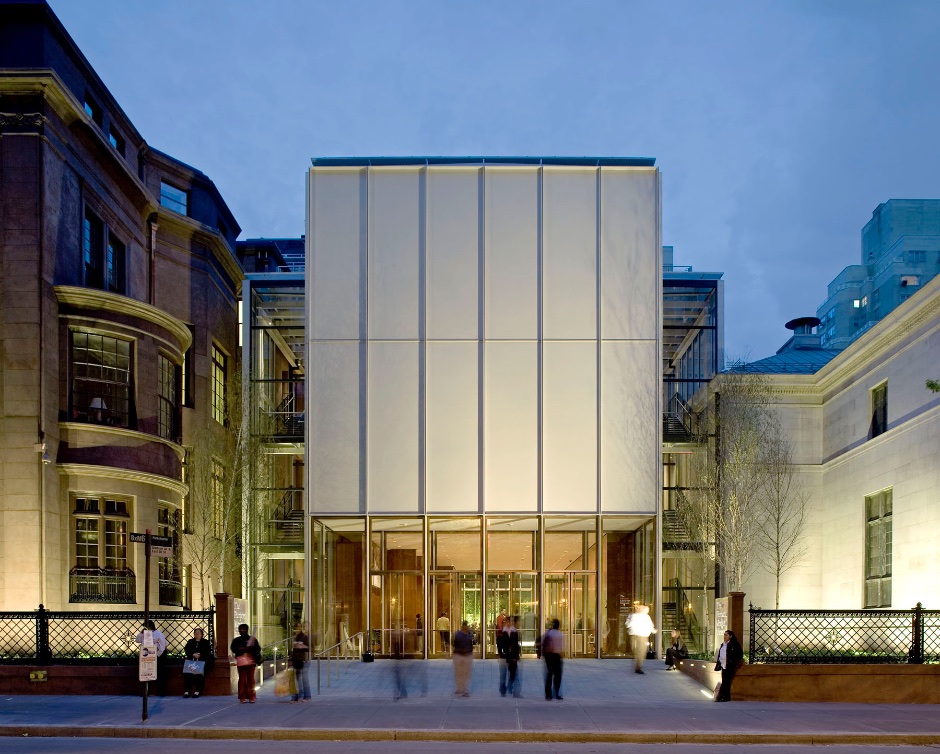
Madison Avenue entrance to the Morgan Library & Museum.
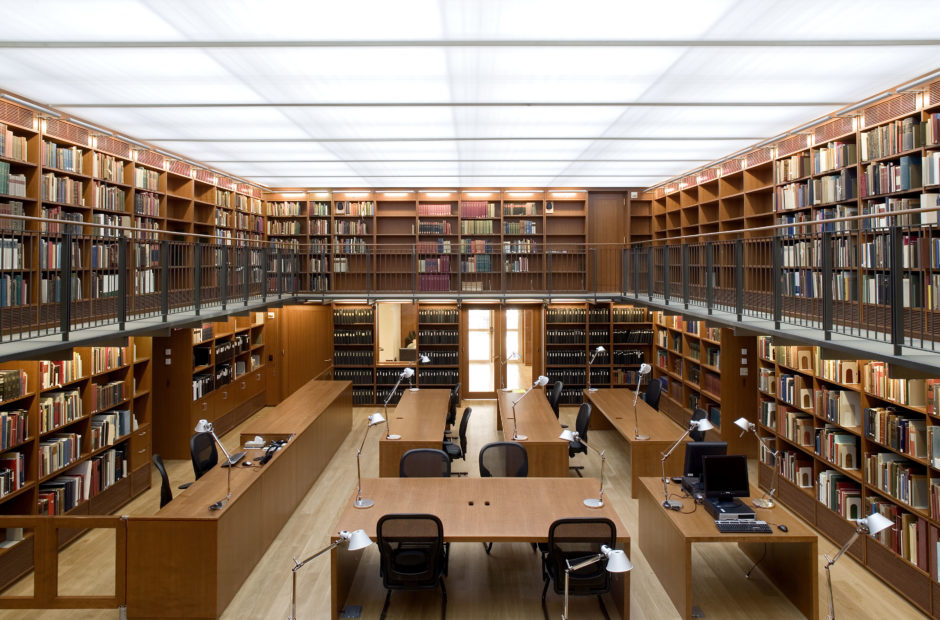
Reading Room
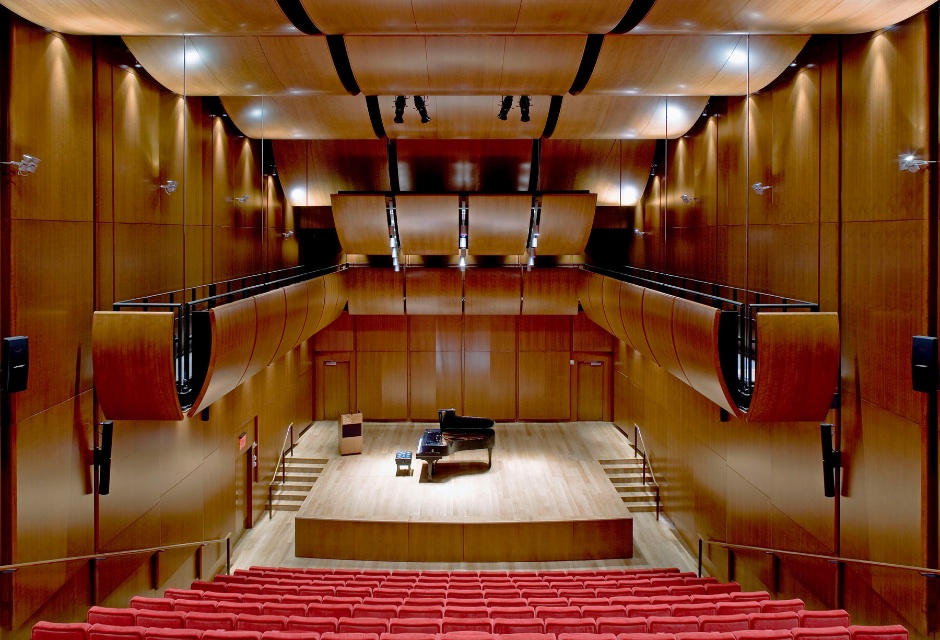
Gilder Lehrman Hall
~~~~~~~~~~~~~~~~~~~~~~~~~~~~~~~~~~~~
Photo Credits
1906 Morgan Library, McKim, Mead & White / Architects — Wurts Brothers Photography.
The Rotunda, Library, Study & Vault — Photography by Graham Haber.
Madison Avenue Entrance — Photography by Michel Denancé.
———————————————-
FIRST FLOOR
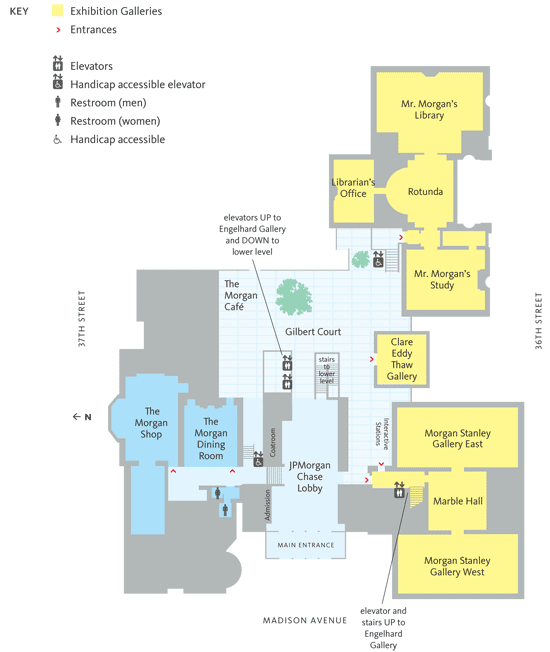
SECOND FLOOR

LOWER LEVEL
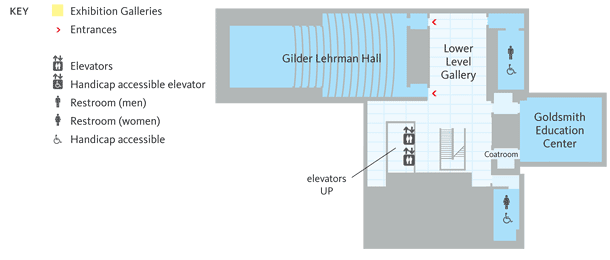
~~~~~~~~~~~~~~~~~~~~~~~~~~~~~~~~~~~~~~~~~~~~
The Morgan Library & Museum
225 Madison Avenue at 36th Street
New York, NY 10016
www.themorgan.org
Tel: (212) 685-0008
Fax: (212) 481-3484
E-mail Visitor Services
Just a short walk from Grand Central and Penn Station, the Morgan is a major exhibition venue for fine art, literature, and music, one of New York’s great historic sites, and a wonderful place to dine, shop, and attend a concert or film.
Hours
The Morgan Library & Museum and the Morgan Shop are open
Tuesday through Thursday: 10:30 a.m. to 5 p.m.
Friday: 10:30 a.m. to 9 p.m.
Saturday: 10 a.m. to 6 p.m.
Sunday: 11 a.m. to 6 p.m.
The Morgan closes at 4 p.m. on Christmas Eve and at 5 p.m. on New Year’s Eve.
Closed Monday, Thanksgiving Day, Christmas Day, and New Year’s Day.
Admission
$20 Adults
$13 Seniors (65 and over)
$13 Students (with current ID)
Free to members and children 12 and under (must be accompanied by an adult)
Admission is free on Fridays from 7 p.m. to 9 p.m.
Admission to the McKim rooms only (Mr. Morgan’s Library, Study, Rotunda, and Librarian’s Office) is free during the following times: Tuesday, 3 p.m. to 5 p.m.; Friday, 7 p.m. to 9 p.m.; Sunday, 4 p.m to 6 p.m.
Admission is not required to visit the Morgan Shop, Morgan Dining Room, and Morgan Café.
~~~~~~~~~~~~~~~~~~~~~~~~~
Images, except as noted, schematics and copy courtesy of the Morgan Library & Museum.
~~~~~~~~~~~~~~~~~~~~~~~~~~~~~~~~
Visit these AAQ Museum Architecture Portfolios (links)
Glenstone, Potomac, Maryland / 2006 – 2008
Harvard Art Museums, Cambridge / 2014
MAD — Museum of Arts and Design, NYC / 2016
Parrish Art Museum, Water Mill, NY / 2012
The Clark Institute of Art, Berkshires / 2014
Wadsworth Atheneum Museum of Art, Hartford / 2017
Whitney Museum of American Art, NYC / 2015
Yale University Art Gallery, New Haven / 2012
________________________________________________
